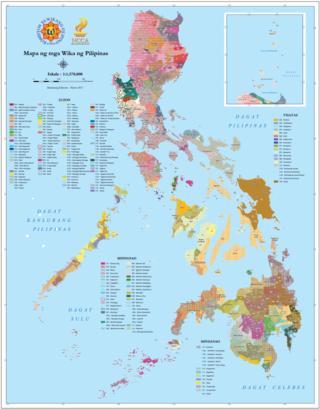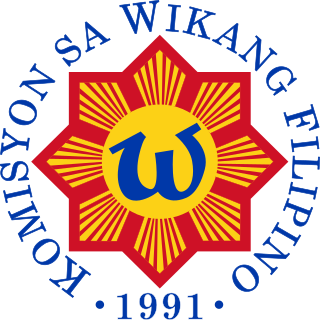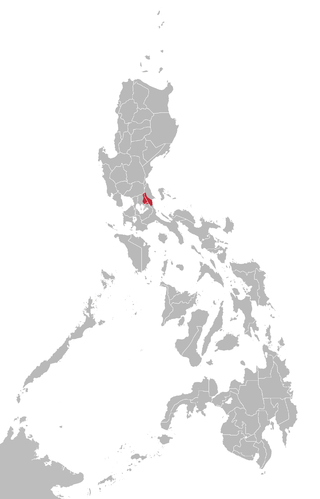Related Research Articles

Southern Tagalog, designated as Region IV, was an administrative region in the Philippines that comprised the current regions of Calabarzon and Mimaropa, the province of Aurora in Central Luzon, and most of the National Capital Region. It was the largest region in the Philippines in terms of both land area and population. After its partition on May 17, 2002, Southern Tagalog continues to exist as a cultural-geographical region.

There are some 130 to 195 languages spoken in the Philippines, depending on the method of classification. Almost all are Malayo-Polynesian languages native to the archipelago. A number of Spanish-influenced creole varieties generally called Chavacano along with some local varieties of Chinese are also spoken in certain communities. The 1987 constitution designates Filipino, a de facto standardized version of Tagalog, as the national language and an official language along with English. Filipino is regulated by Commission on the Filipino Language and serves as a lingua franca used by Filipinos of various ethnolinguistic backgrounds.

The Bisayan languages or Visayan languages are a subgroup of the Austronesian languages spoken in the Philippines. They are most closely related to Tagalog and the Bikol languages, all of which are part of the Central Philippine languages. Most Bisayan languages are spoken in the whole Visayas section of the country, but they are also spoken in the southern part of the Bicol Region, islands south of Luzon, such as those that make up Romblon, most of the areas of Mindanao and the province of Sulu located southwest of Mindanao. Some residents of Metro Manila also speak one of the Bisayan languages.

The Commission on the Filipino Language (CFL), also referred to as the Komisyon sa Wikang Filipino (KWF), is the official regulating body of the Filipino language and the official government institution tasked with developing, preserving, and promoting the various local Philippine languages. The commission was established in accordance with the 1987 Constitution of the Philippines.

Central Bikol, commonly called Bikol Naga or simply as Bikol, is an Austronesian language spoken by the Bicolanos, primarily in the Bicol Region of southern Luzon, Philippines. It is spoken in the northern and western part of Camarines Sur, second congressional district of Camarines Norte, eastern part of Albay, northeastern part of Sorsogon, San Pascual town in Masbate, and southwestern part of Catanduanes. Central Bikol speakers can be found in all provinces of Bicol and it is a majority language in Camarines Sur. The standard sprachraum form is based on the Canaman dialect. The language has also speakers outside their native regional homeland, especially in Metro Manila, Mindoro, Palawan, and Mindanao

Rinconada Bikol or simply Rinconada, spoken in the province of Camarines Sur, Philippines, is one of several languages that compose the Inland Bikol group of the Bikol macrolanguage. It belongs to the Austronesian language family that also includes most Philippine languages, the Formosan languages of Taiwanese aborigines, Malay, the Polynesian languages and Malagasy.

Coastal Bikol is one of the three groups or family languages of Bikol languages. It includes Mt. Isarog Agta, Mt. Iraya Agta, Central Bikol, and Southern Catanduanes Bikol, sometimes classified as a dialect of Central Bikol.

Alabat Island is an island of the Philippine archipelago, in the Quezon Province of the Calabarzon region, situated just off the east coast of Southern Luzon. The island has an area of 192 square kilometres (74 sq mi) and a population of 41,822. The island has a mountain ridge with peaks ranging from 1,083 ft (330.10 m) to 1,384 ft (421.84 m) which look like islands at a distance. The highest peak is called Mt. Camagong.

Remontado, also known by the autonym Hatang-Kayi and in the literature as Kabalat, Remontado Dumagat, and the erroneous names Sinauna/Sinaunang Tagalog, is a Malayo-Polynesian language spoken in Tanay, Rizal, General Nakar, Quezon, Rodriguez, Rizal and Antipolo, in the Philippines. It is one of the Philippine Negrito languages. It is a moribund language.
The Greater Central Philippine languages are a proposed subgroup of the Austronesian language family, defined by the change of Proto-Malayo-Polynesian *R to *g. They are spoken in the central and southern parts of the Philippines and in northern Sulawesi, Indonesia. This subgroup was first proposed by Robert Blust (1991) based on lexical and phonological evidence, and is accepted by most specialists in the field.
The Mamanwa language is a Central Philippine language spoken by the Mamanwa people. It is spoken in the provinces of Agusan del Norte and Surigao del Norte in the Lake Mainit area of Mindanao, Philippines. It had about 5,000 speakers in 1990.
Arta is a highly endangered Negrito language of the northern Philippines.
Manide is a Philippine language spoken throughout the province of Camarines Norte in Bicol region and near the eastern edge of Quezon in Southern Tagalog of southern Luzon in the Philippines. Manide is spoken by nearly 4,000 Negrito people, most of whom reside in the towns of Labo, Jose Panganiban, and Paracale.
The Negrito peoples of the Philippines speak various Philippine languages. They have more in common with neighboring languages than with each other, and are listed here merely as an aid to identification.
Inagta Rinconada is a Bikol language spoken by a semi-nomadic hunter-gatherer Agta (Negrito) people of the Philippines. It is spoken to the east of Iriga City up to the shores of Lake Buhi. The language is largely intelligible with Mount Iraya Agta on the other side of the lake.
Inagta Partido or alternatively Katubung is a nearly extinct Bikol language spoken by a semi-nomadic hunter-gatherer Agta (Negrito) people of the Philippines. It is found on Mount Isarog east of Naga City particularly in the town of Ocampo where the most recent survey of the language was conducted.
Casiguran Dumagat Agta, also known as Casiguran Agta, is a Northeastern Luzon language spoken in the northern Philippines. It is spoken by around 610 speakers, most of whom live in the San Ildefonso Peninsula, across the bay from Casiguran, Aurora.
Umiray Dumaget is an Aeta language spoken in southern Luzon Island, Philippines.
Inagta Alabat is a Philippine Negrito language spoken in central Alabat Island, Philippines. Its speakers began arriving on the island in the 1970s but originated from Villa Espina in Lopez, with earlier settlements in Gumaca and perhaps other towns. Predating the Agta on Alabat Island were communities of individuals self-identifying as "dumagat" but who now only speak Tagalog as a native language. Less than a dozen individuals can still speak the Inagta Alabat language whether on Alabat Island, where it is being lost in favor of Tagalog, or in Lopez, where it is being replaced by the language of the Manide who have migrated to the area in large numbers and intermarried with the Agta, and also replaced by Tagalog. Those Agta who can still speak the Inagta language in Lopez speak the same language as the Agta who have migrated to Alabat over the past 50 years. Other Agta in Lopez either speak only Manide, or a mixture of Manide and Inagta Alabat-Lopez.

The Bikol languages or Bicolano languages are a group of Central Philippine languages spoken mostly in the Bicol Peninsula in the southeastern part of Luzon, the neighboring island-province of Catanduanes, and the island of Burias in Masbate.
References
- ↑ Katabangan at Ethnologue (25th ed., 2022)

- 1 2 3 Zubiri, Louward Allen. 2019. ISO 639-3 Change Request 2019-024.
- ↑ Garvan, John M. 1963. The Negritos of the Philippines. Wiener Beiträge zur Kulturgeschichte und Linguistik Band XIV. Vienna: Ferdinand Berger Horn. (Published posthumously from field notes taken by Garvan between 1903 and 1924.)